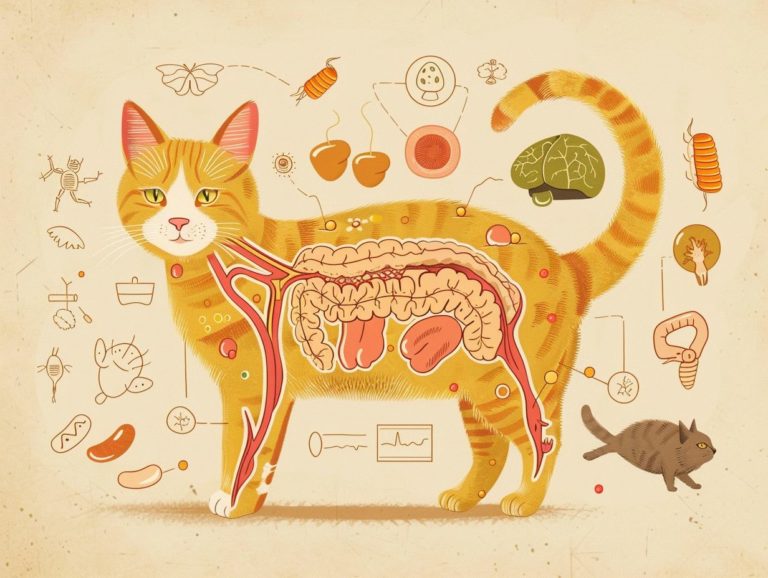The Risks Of Obesity In Cats Health Problems To Watch For
This article examines the dangers of obesity in cats, provides information on the associated health risks, and outlines the signs and symptoms to watch out for.
Additionally, it explores the potential health consequences of obesity in cats and presents effective methods for managing and preventing this significant issue.
Key Takeaways:
The Dangers of Obesity in Cats
Obesity in cats has a severe negative impact on overall health and can shorten their lifespan. Understanding the dangerous implications of excessive weight on cats’ health is essential to promote preventive measures and effective weight management.
Obese cats experience immense joint strain, mobility issues, and a higher risk of developing arthritis. Respiratory problems, diabetes, and heart disease are more prevalent in overweight cats, leading to a decline in their quality of life and potentially requiring specialized veterinary care.
Monitoring their diet and ensuring they engage in appropriate exercise are crucial in preventing feline obesity and enabling your cat to enjoy a better and happier life.
Understanding the Health Risks
Obesity in cats not only results in increased weight but also has detrimental effects on their overall health, impacting their immune system, endocrine functions, and metabolism. Feline obesity is closely linked to serious conditions like cardiovascular diseases. The health consequences of obesity in cats include the following:
- Immune system: Excess body fat in cats can compromise their immune response, making them more vulnerable to infections and diseases.
- Endocrine functions: Obesity is associated with a higher occurrence of endocrine disorders in cats, such as diabetes mellitus, which affects insulin regulation.
- Metabolic functions: Obesity-induced metabolic dysregulation can lead to various systemic health issues due to disruptions in the body’s normal metabolic processes.
- Cardiovascular functions: The excess weight places additional stress on the heart, resulting in cardiovascular issues in cats, including hypertension and heart disease.
Identifying Obesity in Cats
Identifying and diagnosing obesity in cats is crucial to enable early intervention and proper treatment. Recognizing the signs and symptoms of obesity is essential in determining obesity in cats. Common symptoms of obesity in cats include lethargy, difficulty grooming, excessive hunger, and a lack of physical activity.
Diagnostic criteria such as body condition scoring, weight measurements, and assessing the cat’s overall health can be utilized to confirm the presence of obesity. The environment significantly influences the management of a cat’s weight. Factors like proper diet quality, portion control, and opportunities for exercise play a role in a cat’s weight. Regular monitoring and adjustments to the living environment are vital for achieving a healthy weight in cats.
Signs and Symptoms
Clinical symptoms of obesity in cats may include changes in activity levels, decreased mobility, and alterations in grooming habits. Neutered and indoor cats are particularly susceptible to weight gain, as neutering can lower metabolism, leading to potential weight increase if dietary intake is not adjusted. Indoor living conditions often result in reduced physical activity, exacerbating weight gain issues.
Obesity in cats increases the risk of developing diabetes, musculoskeletal problems, and heart disease. It is crucial to monitor a cat’s weight, provide suitable exercise, and ensure proper nutrition for effective weight management and overall health.
Health Problems Associated with Obesity in Cats
Obesity in cats contributes to metabolic disorders, arthritis, and increased disease risk, which are important considerations for effective prevention. Metabolic disorders, such as diabetes mellitus, are a particular concern in overweight cats as obesity can lead to insulin resistance and impact blood sugar regulation. The added stress on joints due to obesity can lead to arthritis, causing pain and mobility issues. Obesity weakens the immune system in cats, making them more vulnerable to various diseases and infections, jeopardizing their overall health.
Regular exercise and a balanced diet are essential for preventing these health issues in cats.
Potential Health Consequences
Obesity in cats can have detrimental health effects, including cardiovascular diseases, decreased mobility, and reduced life expectancy. It is crucial to understand the causes of obesity and find solutions to prevent it in order to mitigate these risks.
When cats are overweight, they face an elevated risk of developing cardiovascular diseases such as hypertension and heart disease. The excess weight places added strain on the heart, increasing the likelihood of serious cardiovascular conditions. Monitoring their weight and providing a balanced diet are essential steps in preventing these health issues. Implementing weight loss strategies like specialized diet plans and regular exercise can significantly improve the health and overall quality of life of cats with weight-related problems.
By preventing obesity, you can ensure a better quality of life for your feline companion.
Managing and Preventing Obesity in Cats
Effectively caring for and preventing obesity in cats involves a comprehensive plan that includes nutritional balance, exercise, and tailored treatment. Preventive measures have been shown to be most effective in ensuring the long-term health of cats. It is advisable to start by evaluating the cat’s current diet and making necessary changes to ensure it is nutritionally balanced and portion-controlled, as discussed in the previous section.
Interactive toys or games that encourage physical activity can help increase exercise levels in cats. Consulting with a veterinarian for specific exercise recommendations and gradually increasing the cat’s activity can be beneficial. Prescription diets and medications may be used to treat obesity in cats, but it is important to note that they do not address the underlying cause of obesity.
Regular veterinary check-ups, monitoring food intake, and reducing the amount of treats given to cats are all preventive measures that can help maintain a healthy weight in cats.
Effective Weight Management Strategies
Effective weight management strategies for feline obesity include customized diet plans, monitoring feeding strategies, and creating an environment conducive to healthy weight maintenance. These strategies should consider the risks associated with obesity for a comprehensive approach.
Customizing the diet based on the unique nutritional requirements of the feline patient is essential for weight control. Personalized meal plans consisting of high-quality, low-calorie diets can aid in weight reduction. Implementing feeding strategies such as portion control and scheduled feeding times is vital to prevent overeating and subsequent weight gain.
Providing a suitable living environment that encourages physical activity through toys, cat trees, and interactive play sessions can also contribute to weight management.
Diet and Exercise Recommendations
Tailored weight loss diets and exercise recommendations are essential for managing obesity in cats. Striking a balance between reduced caloric intake and increased physical activity is crucial for helping cats achieve healthy weight loss.
A well-designed weight loss diet for obese cats is not only important for shedding and maintaining weight but also for preserving lean muscle mass. Obese cats should be provided with well-balanced, nutrient-dense, high-protein, low-carbohydrate, energy-restricted diets with controlled portion sizes to support gradual weight loss.
Incorporating high fiber diets can aid in weight loss, promote gastrointestinal health, and enhance satiety levels. Regular exercise plays a vital role in weight loss and in sustaining weight loss achievements. Customizing the exercise regimen based on the cat’s preferences and physical capabilities is key to ensuring long-term adherence.
An important aspect of weight loss therapy for obese cats is its feasibility within their normal home environment. This approach is significant as it allows cats to enjoy their daily routines while undergoing weight loss and helps them maintain their weight post-treatment.
Frequently Asked Questions
What are the risks of obesity in cats?
The risks of obesity in cats include an increased risk of developing health problems such as diabetes, arthritis, heart disease, and respiratory issues.
How can I tell if my cat is obese?
You can tell if your cat is obese by feeling their ribs – if they are hard to feel or completely covered in fat, your cat may be overweight. You can also look for a lack of a defined waist or an excessive amount of fat around the abdomen.
What health problems should I watch for in an overweight cat?
Health problems to watch for in an overweight cat include diabetes, arthritis, heart disease, and respiratory issues. They may also have decreased energy and difficulty grooming themselves properly.
Can obesity in cats be reversed?
Yes, obesity in cats can be reversed with proper diet and exercise. Consult with your veterinarian for a weight loss plan tailored to your cat’s specific needs.
What are some weight loss strategies for obese cats?
Weight loss strategies for obese cats include reducing food portions, switching to a high-protein, low-carbohydrate diet, and increasing physical activity through playtime and interactive toys.
Are certain cat breeds more prone to obesity?
Yes, certain cat breeds such as Persian, Maine Coon, and British Shorthair are more prone to obesity due to their genetics and metabolism. These breeds may require extra attention to their diet and exercise to maintain a healthy weight.

